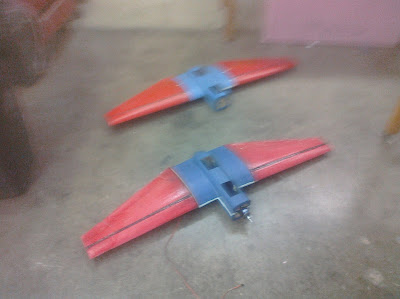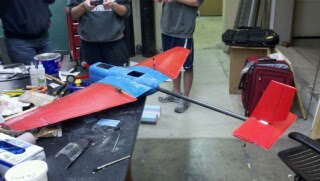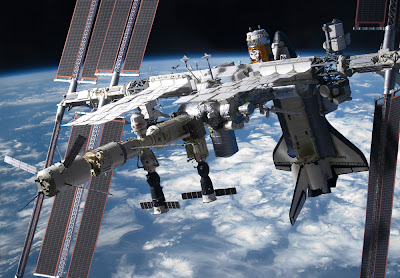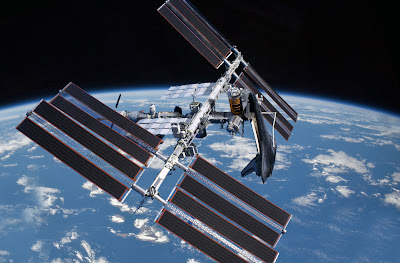Finally, Josh got around to buying the cable he needed to upload all our flight videos, so in a moment that I'm sure will have all of you out there on the edge of your seat, here's the flight videos for the UD AIAA DBF team 2010-2011 season so far. First off, videos from the second round of flights with the prototype on March 20th.
On March 20th, the prototype made two flights, first with a payload of 1.0 lbs, then with a payload of only 0.5 lbs. These was intended to be empty flights, but some tail-heaviness left us in need of nose weight. In fact, on the 0.5 lbs second flight, the reduction in weight left the aircraft very pitchy in flight. However, the propulsion system was finally reaching a configuration that was a bit more in line with the power and duration that we'll need at Tuscon.
Anyway, so that was a week ago. In the past week, we completed and flew V2, our second aircraft. V2 is almost a pound lighter than the prototype (a 20% weight reduction) and reductions in the tail mean that it doesn't have any of the CG issues which plagued the prototype. We managed two flights on Sunday despite the cold on the field. It may look sunny in the videos that follow. It was sunny, but still cold, to the degree that our flight duration on the second flight was constrained not by the plane but by the pilot's fingers getting too cold to keep flying.
For the first flight (video link above), we flew empty, the first properly empty flight we've been able to do all year, thanks to the reductions in weight fixing our CG issues with the prototype. Our normal plane-chucker Kramer Doyle wasn't present, so Josh filled in. On its maiden voyage, V2 did incredibly well--good launch, fast as heck, and no hint of the pitch issues that plagued the prototype. Additionally, we discovered that when in the air, the pinkish wings don't look quite so bad--distance and motion blur cures all wounds, apparently.
Our second flight of the day was a 2.0 lb payload flight--exceeding our original design goal by almost 0.5 lbs. However, even with this, the weight reductions on V2 meant we were still 0.5 lbs below the maximum flight weight from the prototype. Obviously, we had a bit more drama getting into the air this time--as noted, Josh is not our main thrower, and his co-ordination with Chris wasn't quite perfect. However, the result is impressive. This flight had a 35% payload fraction, and if we load the plane to our maximum demonstrated gross weight from the prototype, we'd have gotten a payload fraction of 42%--well in excess of what we were hoping for during the design face. Originally, the fuselage was designed with enough room for about 50% more golf balls than we were designing the wings to lift, for a few reasons too boring to go into. However, it now looks like not only will we fill that volume, but we might have the capability to lift a few more than that!
In the next week, we're going to be putting together the final competition plane, V3. Again, the construction of a third airframe is new to the team's history, and I'm looking forward to further weight trimming. We should also be able to clean up our wing and tail layups a little and get rid of some of the wrinkles we ran into on V2's wings. I have high hopes for V3, and I'm really looking forward to competition.










